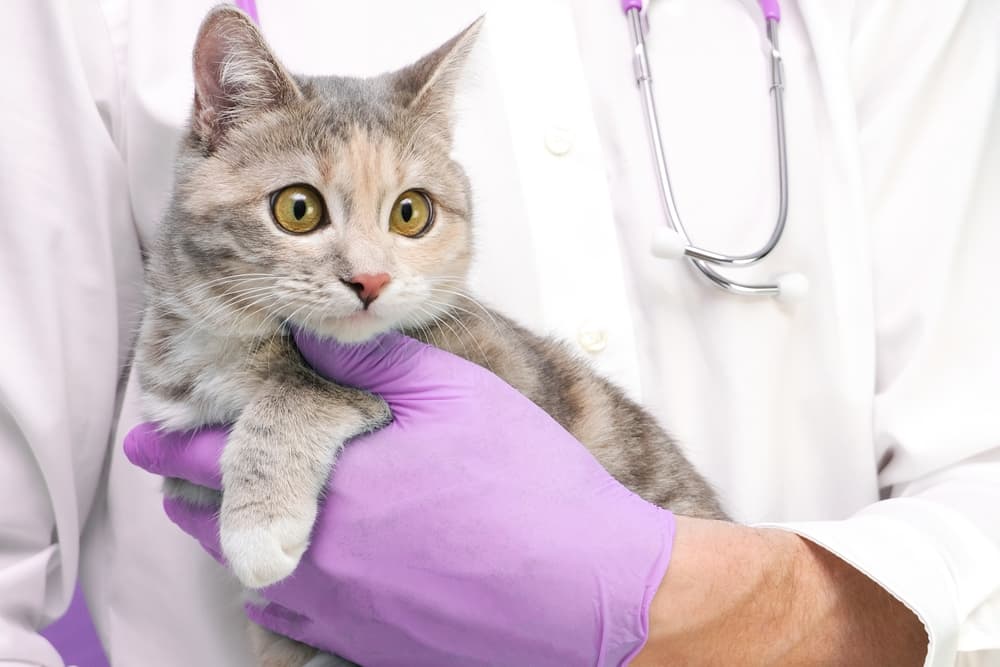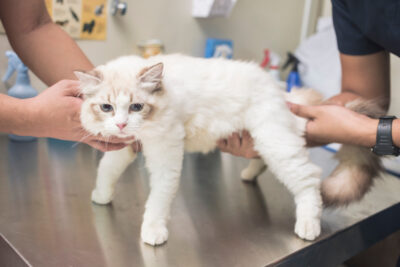Sponsored by CareCredit
Signs of Cancer in Cats: Symptoms to Watch For

Cats are notorious for their inability to hide their disdain. But if you ask a veterinarian, they will tell you cats are excellent at hiding illness. Meaning by the time you notice a change in your cat, she is probably quite sick.
This is why there are no early signs of cancer in cats – cats don’t tell you there is a problem until their symptoms are too severe to hide.
However, being able to recognize possible symptoms of cancer in cats can help you get your cat treatment as soon as possible. As hard as it may be, it’s important to stay calm and not jump to any conclusions. If your cat does require cancer treatment, feeling financially prepared from the start can help give you peace of mind. A solution like the CareCredit health and pet care credit card allows you to pay over time with flexible financing options so you’re ready to get the care your pet needs.*

- Pay over time with flexible financing options*
- Use your card again and again for any type of care your pet needs
- Accepted at most veterinary hospitals**
In this article, we’ll outline general signs pet parents should look out for and also provide the symptoms associated with different types of cat cancer.
9 General Signs of Cancer in Cats
When a cat doesn’t feel well, the first few signs are often the same for many types of illnesses and nearly all types of cancer: they don’t eat and they hide.
Other common symptoms of cancer in cats include:
- Weight loss
- Vomiting
- Diarrhea
- Lethargy (decreased energy)
- Increased thirst
- Urinating outside the litterbox
- New lumps
Keep in mind that many of these symptoms can also be signs of other health problems or diseases. It’s important to have your veterinarian evaluate your cat before jumping to any conclusions.
7 Types of Cat Cancer: Signs and Symptoms

There are many different types of cancer that can impact cats and each has their own signs and symptoms.
Lymphoma
What it is: Cancer of the lymph nodes (immune system)
The most common type of lymphoma in cats is gastrointestinal (GI). It comes in two forms: small cell lymphoma and large cell lymphoma.
Small cell lymphoma acts like a chronic disease in cats and causes vomiting, diarrhea, and loss of appetite.
Large cell lymphoma includes acute signs like severe lethargy and anorexia (full loss of appetite) as well as vomiting and diarrhea.
There are many other types of lymphoma in cats that are not as common as GI lymphoma. These types include:
- Renal (kidneys)
- Hepatic (liver)
- Multicentric (lymph nodes)
- Cutaneous (skin)
Symptoms of renal and hepatic lymphoma include lethargy, vomiting, diarrhea, and inappetence. In multicentric lymphoma, a cat may have swollen lymph nodes under the chin, on the neck, behind the knees, in the armpits, or in the groin. Cutaneous lymphoma signs are similar to a skin infection, such as itchiness and visible skin wounds. Lymphoma can even occur in the eyes, in which case you may notice a change in the shape of the iris or pupil.
Squamous Cell Carcinoma (SCC)
What it is: Cancer of the skin
Squamous cell carcinoma grows quickly and aggressively, meaning that invades other tissue in the area such as bone.. Signs may include ulcerated (bloody) growth that is most often on the face or in the mouth. Signs of mouth cancer in cats include difficulty eating, hesitancy to eat, or excessive drool. Cats with SCC may have bad breath or a foul odor around their face.
Often complete surgical excision for SCC is difficult, if not impossible, and so treatment of this type of cancer in cats is aimed at maintaining good quality of life.
White cats, cats who spend a lot of time in the sun, and cats exposed to tobacco smoke in the home are more likely to develop squamous cell tumors.
Mast Cell Tumors
What it is: Cancer of the skin
Mast cell tumors are often less aggressive than squamous cell carcinomas and can be more easily removed. They look like raised nodules on the skin that may be itchy or bleed and can be found anywhere on the body.
Sarcoma
What it is: Cancer of the muscle, connective tissue, and other soft tissue structures of the body
A sarcoma is cancer of the muscle or soft tissue and general symptoms of sarcomas in cats include a lump or mass that is slow growing, and lameness if the sarcoma is affecting a cat’s limb.
One type of sarcoma, called an injection site fibrosarcoma, is an uncommon but aggressive form associated with locations where cats have received injections of medications, including vaccines. When found on a limb, recommended treatment often includes amputation. In other places on the body, complete surgical excision is unlikely and the cancer is expected to return within several months.
Mammary (Adenocarcinoma)
What it is: Cancer of the mammary glands
Unfortunately, about 90 percent of masses found in the mammary glands of cats are cancerous. These tumors are hormonally driven, so they are more common in cats who have not been spayed or those who were spayed at a later age.
These feel like hard beads near a cat’s nipple. They can become very large and form one mass between teats.
Intraocular Sarcoma
What it is: Cancer of the eye
Older cats with a history of trauma or disease of their eye can develop a type of cancer called post traumatic intraocular sarcoma.
Signs of eye cancer in cats can include visible changes to one eye, such as changes in their iris or pupil shape or new cloudiness. Cats may rub the eye if it is painful. Sometimes cancer of the eye in cats can cause discharge from the eye.
Treatment is surgical removal of the eye. Although this sounds scary, there are many cats who live long happy lives with just one eye. If the eye is painful or they cannot use it to see, then it should be removed.
Osteosarcoma
What it is: Bone cancer
Osteosarcoma is cancer of the bone. It is rare in cats. Signs of bone cancer include limping, decreased activity, resistance to playing, and not jumping on furniture or other objects they used to enjoy perching on. Some cats will also have a decreased appetite. Bone cancer sometimes causes bones to fracture.
There is increased risk for bone cancer among large breed cats, such as Maine Coons and Norwegian Forest Cats.
Other Types of Cat Cancer and Their Signs
There are many additional types of cancers that have more vague symptoms. For example, cancers of the stomach, intestines, or liver can look like intestinal upset with signs like nausea, decreased appetite, diarrhea, and vomiting.
Cancer of the blood or bone marrow may cause tiredness that is mistaken for normal aging.
Lung cancer in cats is more often due to spread (metastasis) of other types of cancers. These are called secondary or metastatic tumors. Primary lung tumors are rare in cats. Signs of tumors in the lung include coughing, decreased energy, difficulty breathing, decreased appetite, and weight loss.
What to Do if You Notice These Symptoms

If you notice concerning changes in your cat, the first thing to do is not to panic. Remember that many things besides cancer can cause cats to feel sick. Think about whether there might be any changes that could relate to your cat’s symptoms. For example, diarrhea after changing her food or sneezing on a heavy pollen day in spring.
Since anything can be a sign of cancer, the most important thing you can do is pay attention to changes in your cat. If your cat is just not acting like herself in any way, make an appointment with your veterinarian for a few days out (3-5 days or when your veterinarian has availability).
If your cat is still showing signs at that point, take her in. If not, cancel the appointment at least 24 hours beforehand. It’s easier than trying to be squeezed in at the last minute and your veterinarian will appreciate it. Of course, if your cat worsens before the appointment, try to get an immediate appointment or go to the emergency clinic.
Any lump that is bigger than 1cm (1/2 inch), is there for more than a month, grows, changes, bleeds, or doesn’t look/feel like the other lumps on your cat should be examined. It is always easier (safer, less painful, less expensive) to remove a small mass than a big one especially on the limbs and face. Any growth that suddenly changes should be examined.
If your cat does something that concerns you or you notice a new lump, it is best to let a veterinarian examine your cat. Some types of cancers, such as mammary nodules, can be found on a physical exam. Others require blood work, X-rays, or an ultrasound to pinpoint. These are also important tests in assessing your pet’s overall health.
After locating an abnormality that is suspected to be cancer, the first step is taking a small sample of the cells to look at under a microscope. This is called an aspirate. Often a diagnosis of cancer versus just a benign lump can be made based on this initial sample but sometimes it cannot be. If a diagnosis cannot be made, then your veterinarian may recommend something called an “excisional biopsy” where the suspicious mass is surgically removed as both diagnostic test and treatment. However, it is ideal to know whether the mass is cancer before removing so that your veterinarian can take appropriate margins (healthy tissue around the mass) and no cancer is left behind.
While surgery is recommended for many types of cancers, there are some cancers that are treated only with chemotherapy or radiation therapy, such as lymphoma.
On average, the cost of treating cancer in cats for the first year is $3,800.”
Source: Pets Best claims data from 2017 – 2021 for average 1st year condition costs.
On average, the cost of treating cancer in cats for the first year is $3,800, according to Pets Best claims data.1 While a pet health insurance plan may help offset costs, flexible financing with CareCredit can be another tool in your arsenal. Whether your cat needs diagnostic tests, surgery or chemotherapy, you can use your card again and again for your pet’s procedures at any provider in the CareCredit network.*
In Conclusion
Because the signs of cancer in cats are broad and can mimic those of other diseases and health problems, it’s important to discuss any concerns you may have with your veterinarian.
Your veterinarian will be able to run appropriate diagnostic tests or conduct imaging procedures that can identify whether your cat’s symptoms are cancer or being caused by something else.
And if your cat does have cancer, don’t lose heart. Many feline cancers can be effectively treated or managed, offering your cat a good quality of life despite a cancer diagnosis.
1Pets Best claims data from 2017 – 2021 for average 1st year condition costs.
*Subject to credit approval. See carecredit.com for details.
**Internal estimates based on publicly available market sizing information, as of Feb 2023
This information is shared solely for your convenience. Neither Synchrony nor any of its affiliates, including CareCredit, make any representations or warranties regarding the products described, and no endorsement is implied. You are urged to consult with your individual veterinarian with respect to any professional advice presented.









